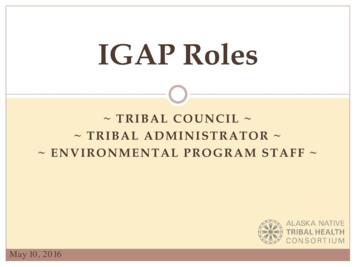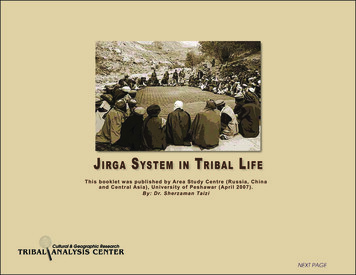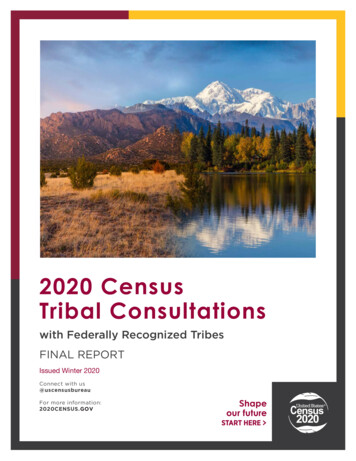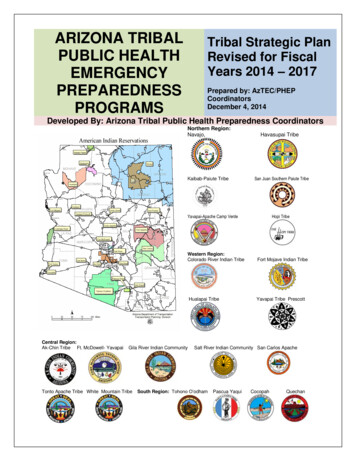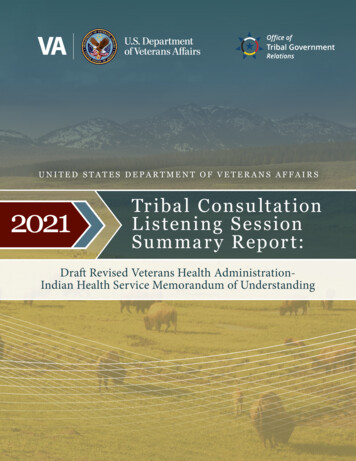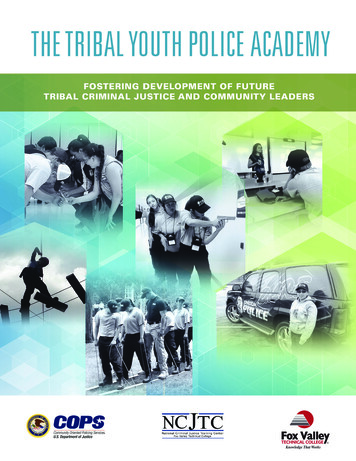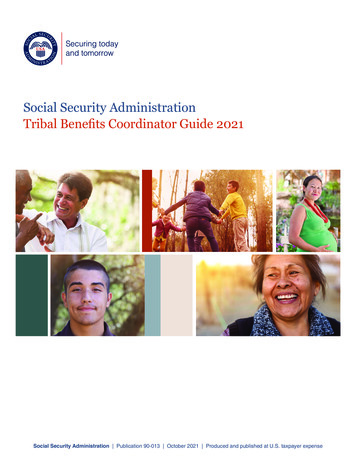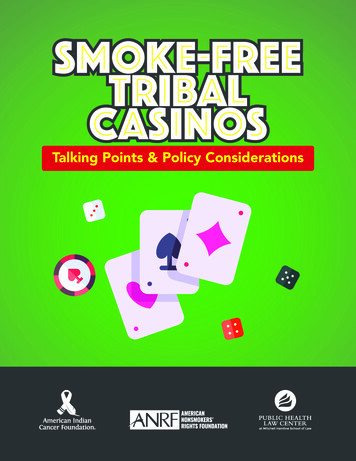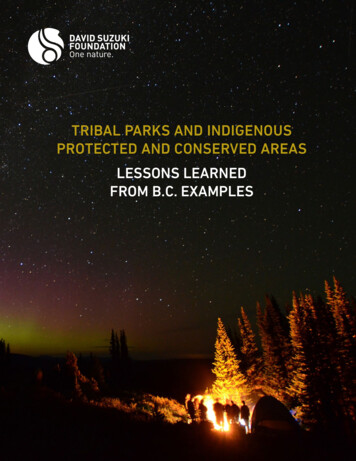
Transcription
TRIBAL PARKS AND INDIGENOUSPROTECTED AND CONSERVED AREASLESSONS LEARNEDFROM B.C. EXAMPLES
ACKNOWLEDGEMENTS: Thanks to knowledge-holders, leaders and elders from Doig River,Yunesit’in and Xeni Gwet’in First Nations for contributing expertise, insights and time. We couldnot have completed this report without their support, vision and knowledge. Thanks to NadineCrookes from Parks Canada, Steven Nitah from the Indigenous Leadership Initiative and Eli Ennsfrom the Indigenous Circle of Experts for interviews, and to Steven Ferguson who volunteeredto transcribe the interviews. The map was created by Willem Van Riet, David Suzuki Foundation.Thanks also to reviewers Kim Wright, Eli Enns, Melissa Mollen Dupuis and Paula Hill.TRIBAL PARKS AND INDIGENOUS PROTECTED AND CONSERVED AREAS: LESSONS FROM B.C.August 2018Project lead: Rachel Plotkin, David Suzuki FoundationTechnical support: Jonaki Bhattacharyya,Carolyn Whittaker and The Firelight GroupThis report was made possible by the generoussupport of the Real Estate Foundation of B.C.DISCLAIMER: The contents of this report are the responsibility of the authorsand do not necessarily reflect the views and opinions of the funders (REFBC),collaborators, individuals or communities that contributed to its development.Information contained herein should not be construed as to define, limit orotherwise constrain the treaty and rights or title of Indigenous Peoples.Cover photo courtesy River Voices ProductionsGraphic design by Nadene Rehnby, Hands On PublicationsISBN 978-1-988424-22-4Canadian Cataloguing in Publication Data for this reportis available through Library and Archives CanadaDisponible en français219 – 2211 West 4th Avenue, Vancouver, BC V6K 4S2Phone 604-732-4228 or toll free at 1-800-453-1533davidsuzuki.org
Tla-o-qui-ahtTribal Parks.EXECUTIVE SUMMARY. 4Section 1 Introduction to Indigenous Protected and Conserved Areas. 7Section 2 Why establish an IPCA?.19Indigenous title, rights, stewardship and spiritual places in IPCAs. 20Protecting lands, waters, wildlife. 21Sharing language, knowledge and culture. 23Healing people and the land together. 25Section 3 Experience establishing IPCAs — selected themes.26Community involvement and engagement. 27Indigenous governance. 29Land-use planning. 35Managing industrial disturbance. 39Establishing a healthy economy for sustainable livelihoods. 40Operational challenges. 42Section 4 Looking forward: the role of restoration areas.45Section 5 Summary of lessons shared.48Checklist of IPCA tools. 50Section 6 Conclusion.52References cited.54PHOTO COURTESYJEREMY WILLIAMS/RIVER VOICES
EXECUTIVE SUMMARYDASIQOX TRIBAL PARK, PHOTO RIVER VOICES PRODUCTIONSINDIGENOUS COMMUNITIES ACROSS CANADA are taking the lead in protecting the places thatare essential to them. Indigenous Protected and Conserved Areas (IPCAs) aim to safeguardIndigenous rights — including the right to exercise free prior and informed consent — whilealso maintaining biodiversity, and securing a space where communities can actively practiceIndigenous ways of life. The initiatives by Indigenous groups in B.C. to establish IPCAs that areprofiled in this report provide some excellent examples of Indigenous-led land stewardship andgovernance.Experts and Indigenous community knowledge-holders involved in establishing K’ih tsaa?dze,Nexwagweẑʔan – Dasiqox Tribal Park, and Tla-o-qui-aht Tribal Parks, as well as advisers fromthe Canadian Indigenous Circle of Experts, provided interviews and shared stories to inform thisreport. Their voices are woven throughout it to bring forward a diverse set of themes rangingfrom the role of elders in creating the vision for IPCAs, to sustainable livelihood initiatives, to theneed to restore areas that have been impacted by industrial disturbance.This report builds on some important foundational work from previous studies including the recent work completed by the Canadian Indigenous Circle of Experts (ICE) titled We Rise Together:Achieving Pathway to Canada Target 1 through the Creation of Indigenous Protected and ConservedAreas in the Spirit of Practice and Reconciliation.1 The ICE report sets out conceptual recommendations for establishing a system of Indigenous Protected and Conserved Areas across Canada.14Indigenous Circle of Experts, We Rise Together: Achieving Pathway to Canada Target 1 through the Creationof Indigenous Protected and Conserved Areas in the Spirit and Practice of Reconciliation, March ogether/TRIBAL PARKS AND INDIGENOUS PROTECTED AND CONSERVED AREAS: LESSONS FROM B.C.
Recent changes in government policy contexts have hinted at supporting IPCAs, but legislativetools to secure these areas from development pressures are still not available.The report explores six key themes that emerged from the interviews and literature reviewincluding:1. Community involvement and engagement;2. Indigenous governance;3. Land use and management planning;4. Management of industrial disturbance;5. Establishing a healthy economy for sustainable livelihoods; and6. Operational challenges.KEY ELEMENTSSome of the lessons learned profiled in the report are important elements in establishing an IPCA. A clear vision and mandate — Many knowledge holders andleaders emphasized the importance of working with elders andcommunity members to identify a vision for each IPCA, so thatall further work is rooted in a strong mandate based on thevoices of community members. Utility of land-use planning — Indigenous land use planningprocesses can serve as a useful tool, when driven by and tailoredto Indigenous communities, for developing the guidelines thatleaders, staff, and external agencies need to manage the IPCA.The initiatives byIndigenous groups inB.C. to establish IPCAsthat are profiled in thisreport provide someexcellent examplesof Indigenous-ledland stewardshipand governance. Interim protection — A key theme is the critical need for interim measures to protectIndigenous territories while communities go through the process of management planning and negotiations. Proactive and strategic communications — Taking a proactive approach to communications about an IPCA was highlighted as a key aspect of the work in securing IPCAs. Thispoint includes open communications between community members and leadership, aswell as taking the lead in messaging to the broader public, other governments, and interest groups. Internal cooperation — Some leaders highlighted the importance of nurturing internalcooperation among and between Indigenous communities and leaders, in order to effectively negotiate for, and manage, IPCAs within their territories.DAVID SUZUKI FOUNDATION5
Relationships with other governments — Declaring an IPCA and governing it means thatIndigenous governments face decisions about how they want to relate to other governments on all matters pertaining to the new jurisdictional declaration. Role for restoration — IPCAs are generally in areas that face impacts from a variety ofsources (e.g., industrial activity, forest fires, road-building, motorized vehicle use), andIndigenous peoples often place a high priority on healing or restoring the land and people,together. The importance of culture and language in IPCA establishment — Indigenous protectedareas are as much about practising ways of life and holding space for peoples’ culturalrelationships, as they are about the land. Culture and language revitalization are centralto IPCAs.The report includes a checklist of tools for those initiating work on IPCA establishment.The work of Indigenous communities in establishing IPCAs clearly points to the need for atransformative shift in the way that conservation areas are approached in Canada. This shiftwill require that resources be directed to Indigenous peoples and nations for planning, capacitybuilding, and nation-building. It will also require a re-examination of protected area jurisdictionand management at all levels of government.The work of Indigenouscommunities in establishingIPCAs clearly points to theneed for a transformativeshift in the way thatconservation areas areapproached in Canada.Ultimately, IPCAs in B.C. and Canada are rooted in theexercise of constitutionally upheld Indigenous rights inaccordance with Indigenous laws. Exercising agencyin how these lands are managed and protecting andconserving space to practise Indigenous preferred livelihoods on the land may seem “new,” but these practicesare much older than our current governance structuresand land jurisdiction.We must work together to change the structures thatgovern how lands are managed so that Indigenous communities are empowered with capacity,tools and a supportive regulatory landscape to successfully establish and govern IPCAs.K’IH TSAA?DZE TRIBAL PARK PHOTO COURTESY EMMA GILCHRIST6TRIBAL PARKS AND INDIGENOUS PROTECTED AND CONSERVED AREAS: LESSONS FROM B.C.
SECTION 1INTRODUCTION TO INDIGENOUSPROTECTED AND CONSERVED AREASPHOTO RACHEL PLOTKIN“Our people said without a doubt they wanted a tribal park, because theywanted our people to be in that driver’s seat. So that would be us managingthe process and managing the territory.” — Marilyn Baptiste, Xeni Gwet’in2INDIGENOUS PROTECTED AND CONSERVED AREAS (IPCAs)3 are a model for landmanagement in Canada that supports both ecosystems and human use of the land.These lands are managed by the Indigenous communities on whose traditional territory the protected areas are established, in ways that are culturally appropriateand sustainable. IPCA designations link Indigenous communities to the land throughactive practices of Indigenous ways of life.23Marilyn Baptiste, who has served as Chief, and as a Councillor for Xeni Gwet’in First NationGovernment. May 7, 2017a, interview XG01, transcript.IPCAs are often referred to in international arenas as Indigenous and Community ConservedAreas, or ICCAs. In Canada, they are also referred to as Indigenous Protected Areas or TribalParks. ICE uses a definition: IPCAs are lands and waters where Indigenous governmentshave the primary role in protecting and conserving ecosystems through Indigenous laws,governance and knowledge systems. We Rise Together: Achieving Pathway to Canada Target 1through the Creation of Indigenous Protected and Conserved Areas in the Spirit of Practice andReconciliation, 2018, p. 35.DAVID SUZUKI FOUNDATION7
Many existing protected areas exclude Indigenous practices and, in some instances, forciblyremoved Indigenous Peoples from the land.4 Supporting IPCAs advances reconciliation byrecognizing and upholding Indigenous rights (including treaty rights and the right to selfdetermination) and Indigenous peoples’ self-described responsibilities to manage and stewardtheir traditional territories.There are many forms of IPCAs. This report brings forward some lessons learned from threetribal parks (a form of IPCA) in Canada: two emerging examples, and one of the first tribal parksestablished in Canada: K’ih tsaa?dze Tribal Park declared by Doig River First Nations in 2011; Nexwagweẑʔan – Dasiqox Tribal Park established by Yunesit’in and Xeni Gwet’in(Tsilhqot’in communities) in 2014; and Tla-o-qui-aht Tribal Parks – Wah’nah’juss Hilth’hoo’iss (Meares Island) Tribal Parkestablished in 1984 by Tla-o-qui-aht and Ahousaht First Nations. (Tla-o-qui-aht haveestablished three additional Tribal Parks: Ha’uukmin, Tranquil and Esowista Tribal Parks,collectively known as the Tla-o-qui-aht Tribal Parks).(See map and profiles of the three parks on the following pages.)This report builds on the Indigenous Circle of Experts (ICE) report for Canada’s Pathways toTarget 1, 2020, We Rise Together (2018), which the David Suzuki Foundation and the FirelightGroup support. The ICE report calls for nongovernmental organizations and other allies to support and partner with Indigenous governments as they develop, implement and manage IPCAs.5The authors have collaborated with experts from Doig River, Yunesit’in, Xeni Gwet’in and Tlao-qui-aht First Nations, as well as other advisers, to bring forward some lessons learned frompractitioners. Research has been compiled from stories and insights shared by informantsgained through their experiences in establishing IPCAs. This report can be used in three ways:1. By the Indigenous Peoples who contributed to this report to gain support for IPCAs;2. As a resource for other Indigenous people and First Nations who want to establish theirown IPCAs; and3. To build broader awareness and understanding of IPCAs.458Mulrennan M., “Aboriginal peoples in relation to resource and environmental management,” in Resource andEnvironmental Management in Canada: Addressing Conflict and Uncertainty, ed. Mitchell B, 5th ed. (Toronto:Oxford University Press, 2015); Dowie M., Conservation Refugees: The Hundred-Year Conflict between GlobalConservation and Native Peoples (Cambridge: MIT Press, 2009); Notzke C., Aboriginal Peoples and NaturalResources in Canada (North York: Captus University Publications, 1994).Indigenous Circle of Experts, We Rise Together, Recommendation #16, p. 61.TRIBAL PARKS AND INDIGENOUS PROTECTED AND CONSERVED AREAS: LESSONS FROM B.C.
!WhitehorseAtlinWatson Lake!!Lower PostAtlin LakeortheFort Nelson!s ternProphet River!MounA L B E RTAWonowon!RangesB R I T ISHC O L U MBIAStewart !Fort St. John!BabineLakeHouston !!WhitecourtPrince GeorgeInLakeabasca R iverA th!Fox Creek !rHaida GwaiiIslandste16 rioCr Pl! Quesnele!Williams Lakeous!! opulated PlaceHighwayOther RoadInternational BoundaryProvincial BoundaryWah'nah'juss Hilth'hoo'iss(Meares Island) Tribal ParkEsowista Tribal ParkTranquil Tribal ParkHa'uukmin Tribal ParkWest Moberly Area ofCultural Conservation InterestGwaii Haanas National ParkReserve and Haida Heritage Site3 YTBCAB!!FernieKalispell!MONTANASpokane !Dasiqox (Yunesit’in andXeni Gwet’in First Nations)K'ih ts aaʔdze Tribal Park(Doig River First Nation)Sparwood!IDAHOWASHINGTON!!NelsonCastlegar !!Trail !CanadaUnited States of Am erica!High River!Invermere!n tainsVancouver!!2505 Victoria1:7,000,0001 ! Salmon ArmVernonM ou19 !AirdrieBanff!! CalgaryStrathmore! !!Goldeniamb!NanaimoPort Alberni !Pemberton!!Whistler991 bell River!Powell River!Vancouver!Island CourtenayN o r t h P a cificO c e an5 97 !Port HardyRed DeeryainntouM!ta! Jasperck!MlHancevilleEdmontonn Ri v e r !ew a Leduc!EdsonHinton !KinbasketLake Roauastoaat!Anahim Laken!!raser R LesserSlave Lake Slave LakeGrande Prairieive!Tlell97 Fort St. James!Burns Lake !16 Fraser Lake!!OotsaVanderhoof!Kitimat!DawsonCreek!Tumbler RidgeFMasset !!ChetwyndMackenzie !Peace River!verTerrace!!P eaceRi!WillistonLakeSmithersPeaceRiver!97 t a in 37High Levelrn P la i n sEaicaA me r!Fort WarePrince Ruperta s tedaftes oCanad Sta! IskutALASKA!EnterpriseNUnit e!TahltanToad River!Dease Lake!NORTHWESTTERRITORIES! Fort Liard!Good Hope LakeGreatSlave LakeSaNo rth skatch!Fort Providence!YUKONTeslinLakeNTVNUSK MBONQCNFNBDAVID SUZUKI FOUNDATIONNS9!
DASIQOXK’IH TSAA?DZENAME: Nexwagweẑʔan – Dasiqox Tribal ParkNAME: K’ih tsaa?dze Tribal Park(K’ih tsaa?dze means “old spruce” inthe Dane-za, or Beaver, language)LOCATION: 300 km north of VancouverBACKGROUND: In Tsilhqot’in territory, aprecursor to the Dasiqox Tribal Park wasthe Nemiah Aboriginal Wilderness Preserve,established by the Xeni Gwet’in First Nationin 1989. Tsilhqot’in First Nation establishedDasiqox Tribal Park as an expression ofits right to govern and manage uncededterritory. The motivation to establish thepark came directly from elders, who insistedon protecting an area for the continuedpractice of rights andresponsibilities to the land.LOCATION: Northeastern B.C.,Northwestern AlbertaBACKGROUND: K’ih tsaa?dze has long been aplace of spiritual importance to the communitymembers of Doig River. The nation has negotiatedlogging deferrals with many of the companiesoperating within K’ih tsaa?dze’s boundaries, andis currently in conversations with the provinces ofB.C. and Alberta to explore co-governance models.ESTABLISHED: 2011SIZE: 90,000 hectaresESTABLISHED: 2014SIZE: almost 300,000 hectaresMAP: dasiqox.org/about-us/map/K’IH TSAA?DZEMAP: LA-O-QUI-AHTTLA-O-QUI-AHTNAME: Tla-o-qui-aht Tribal Parks – Wah’nah’juss Hilth’hoo’iss (Meares Island) Tribal ParkLOCATION: At the heart of the Clayoquot Sound UNESCO Biosphere Reserve on the west coast ofVancouver IslandBACKGROUND: Tla-o-qui-aht Tribal Park (otherwise known as Meares Island) was declared a TribalPark by Ha’wiih (hereditary chiefs) in 1984 in response to unsustainable logging practices that wereimpinging on traditional territories. Since then, the Tla-o-qui-aht have established three additionaltribal parks: Ha’uukmin (Kennedy Lake Watershed), Tranquil Tribal Park and Esowista Tribal Park.ESTABLISHED: 1984SIZE: 21,249 hectaresMAP: ns/2013 tla-o-qui-aht Paper-Web-2.pdf10TRIBAL PARKS AND INDIGENOUS PROTECTED AND CONSERVED AREAS: LESSONS FROM B.C.
This report identifies core building blocks for establishing IPCAs. It reviews the policy contextfor IPCAs (Section 1), explores reasons for establishing IPCAs (Section 2) and identifies themesshared among various Indigenous protected area initiatives (Section 3) such as the importanceof community engagement, the challenges in managing industrial activities, and the role ofIndigenous governance. This report also identifies the emerging theme of the need for restoration areas in highly degraded landscapes (Section 4), and offers a summary of lessons sharedand a checklist of tools for establishing IPCAs (Section 5).POLICY CONTEXT FOR IPCAS IN CANADA AND INTERNATIONALLY“If Indigenous cultures can continue to thrive into the future, then you are doingsomething right because the land is so central to Indigenous cultures. If you havea healthy culture, then the land will be healthy as well.” — Dahti Tsetso, ResourceManagement Coordinator, Dehcho First Nations6Currently, protected areas are categorized through a variety of jurisdictional designations thatinclude: UNESCO world heritage sites and biosphere reserves; National parks; Provincial parks; Conservancies; and Co-management agreements.These existing formal designations have had limited success in supporting Indigenous Peoples’governance and right to manage the land. By asserting an Indigenous vision for land and resource use and an Indigenous or co-governance framework for decision-making, Indigenouscommunities that establish IPCAs are exercising a proactive form of leadership.IPCAs are an assertion of Indigenous rights that resonate with section 35 of Canada’s Constitution,as well as international declarations that Canada has pledged to support, such as the UnitedNations Declaration on the Rights of Indigenous Peoples, in a form that is new in a Canadiancontext. Although there are clear links between the recognized rights of Indigenous Peoples andthose asserted by First Nations governing IPCAs, it does not follow that IPCAs are, themselves,appropriately recognized and supported by provincial, territorial or federal governments inCanada. The understanding of conservation among Canadians must undergo a transformativeshift to advance and secure the establishment of IPCAs.6Dahti Tsetso, interview by the Indigenous Circle of Experts, The Indigenous Circle of Experts year in review2017, Facebook, March 27, 2018. .DAVID SUZUKI FOUNDATION11
FPIC, UNDRIP and reconciliation“Built into the constitutional foundation stones of this country is a commitment torespect one another and to respect the water and the land that we all depend on.”— Eli Enns, co-chair of ICE7UNDRIP and free, prior and informed consentAt the United Nations in New York on May 9, 2016, Minister of Crown-Indigenous Relations andNorthern Affairs Carolyn Bennett and Minister of Justice and Attorney General Jody WilsonRaybould announced that Canada fully endorsed the United Nations Declaration on the Rights ofIndigenous Peoples (UNDRIP) (see sidebar on page 14).8On-the-ground realities for Indigenous Peoples in British Columbia and throughout Canada haveincluded destruction and degradation of natural ecosystems, steep declines in and loss of localwildlife populations, and the overall failure of provincial,territorial and federal governments to effectively manageAs conversations thatcumulative impacts to ensure that where industrial acinformed this reporttivities occur, ecosystem health is maintained. These exrevealed, Indigenousperiences have led to a significant mistrust of provincial,communities are stillterritorial and federal governments as land managers.not sufficiently (if at all)included at decisionmaking tables pertainingto land-use decisions.The mistrust of government is rooted in Canada’s historyof colonialism, including systemic racism, policies toeliminate Indigenous governments and ignore Indigenousrights, destruction of Indigenous social institutions, banning of Indigenous languages and spiritual practices, confiscation and destruction of objects of spiritual value, forced relocation and residential schools.9This history has created enduring legacy effects.As conversations that informed this report revealed, Indigenous communities are still notsufficiently (if at all) included at decision-making tables pertaining to land-use decisions. Onecommunity member expressed frustration at being constantly consulted for resource extractionprojects but, no matter what was said, all consultations seemed to lead to a project outcome of“yes.”10Eli Enns, interviewed by Steve Paikin, Checking in on Conservation in Canada, TVO, March 26, 2018.“United Nations Declaration on the Rights of Indigenous Peoples,” adopted September 13, 2007, G.A. Res.61/295, U.N. Doc. ion-on-the-rights-of-indigenouspeoples.html.9 List adapted from the introduction of the TRC report. Truth and Reconciliation Commission of Canada.“Honouring the Truth, Reconciling for the Future,” 2015. Exec Summary 2015 05 31 web o.pdf.10 Clarence Wilson, West Moberly First Nation, conversation, June 12, 2017.7812TRIBAL PARKS AND INDIGENOUS PROTECTED AND CONSERVED AREAS: LESSONS FROM B.C.
To date, the federal government’s progress in upholding FPIC is merely inthe form of commitments made to create new processes and approachesaimed at securing consent.11 It has not introduced any new policies toenshrine FPIC principles, for which it has come under fire.12Reconciliation“Without recognition through Crown legislation, any protectedarea that is led by Indigenous Peoples could be an area ofconflict. Is that reconciliation? I don’t think so.” — Steven Nitah,Indigenous Leadership Initiative 13The commitment to advance FPIC is coupled with a national recognitionof the need for reconciliation with Indigenous Peoples in Canada, rootedin the space created by the Truth and Reconciliation Commission forCanadians to hear stories about, acknowledge and move toward healingthe intergenerational trauma from the country’s history of residentialschools.The Truth and Reconciliation report outlines that, in addition to the devastation caused by residential schools,Canada asserted control over Aboriginal land. In some locations,Canada negotiated Treaties with First Nations; in others, theland was simply occupied or seized. The negotiation of Treaties,while seemingly honourable and legal, was often marked byfraud and coercion, and Canada was, and remains, slow toimplement their provisions and intent.14Reconciliation must address the forced removal of Indigenous Peoplesfrom their lands, broken treaty processes and promises, and the exclusionof First Nations from decisions about how their traditional territories wereand are managed. In this context, IPCAs are initiatives that warrant the respectful attention of provincial, territorial and federal governments committed to advancing reconciliation, as well as stakeholders and citizens.11 “Principles respecting the Government of Canada’s relationship with Indigenouspeoples,” Government of Canada, last modified February 14, 2018, l.12 James Munson, “Wilson-Raybould defends stand on UNDRIPadoption,” iPolitics (July 22, 2016), ends-stand-on-undrip-adoption/.13 Steven Nitah, March 20, 2018, interview TE03, transcript.14 “Honouring the Truth, Reconciling for the Future,” Truth and ReconciliationCommission of Canada, p. 1.CONSULTATION:Although governments arebound by Supreme Courtdecisions (Haida, TakuRiver, Mikisew Cree, LittleSalmon/Carmacks andRio Tinto)a to consult withIndigenous Peoples priorto development activitiesin traditional territoriesand to accommodatetheir interests, in manyinstances the consultationprocesses have beendevolved to industry, andthe consultation efforts areoften deemed insufficientby First Nations.aGovernment of Canada andthe duty to consult, ec1JUVENILE BALD EAGLEPHOTO COURTESY SADIE PARR13
“As informed by the UN Declaration, Indigenous peoples have aunique connection to and constitutionally protected interest in theirlands, including decision-making, governance, jurisdiction, legaltraditions, and fiscal relations associated with those lands.”GOVERNMENT OF CANADA’S 2017 PRINCIPLES PERTAININGTO ITS RELATIONSHIP WITH INDIGENOUS PEOPLESIn July 2017, the Department of Justice released 10 principles respecting theGovernment of Canada’s relationship with Indigenous Peoples. These include:PRINCIPLE ONE:“The Government of Canada recognizes that allrelations with Indigenous peoples need to be basedon the recognition and implementation of theirright to self-determination, including the inherentright of self-government. This principle reflectsthe UN Declaration’s call to respect and promotethe inherent rights of Indigenous peoples. Thisincludes the rights that derive from their political,economic, and social structures and from theircultures, spiritual traditions, histories, laws, andphilosophies, especially their rights to their lands,territories and resources. (emphasis added) As informed by the UN Declaration,Indigenous peoples have a unique connectionto and constitutionally protected interest in their lands, includingdecision-making, governance, jurisdiction, legal traditions, and fiscalrelations associated with those lands.” (emphasis added)PRINCIPLE SIX:“The Government of Canada recognizes that meaningful engagement withIndigenous peoples aims to secure their free, prior, and informed consentwhen Canada proposes to take actions which impact them and their rights,including their lands, territories and resources.” (emphasis added)“Principles respecting the Government of Canada’s relationship with Indigenous peoples,”Government of Canada, 2018, l.14TRIBAL PARKS AND INDIGENOUS PROTECTED AND CONSERVED AREAS: LESSONS FROM B.C.
According to Steven Nitah, an advisor to the Indigenous LeadershipInitiative, “The role of governments should be as a partner, as wasoriginally intended in the treaties. The way I understand it is that weagreed to share the land and the benefits from it. That’s the mandatethat I’ve been following from the beginning, in the spirit and intent ofthe peace and friendship treaty.”15Ultimately, the potential for governments to recognize and uphold IPCAsrepresents a significant opportunity in the path toward honouring FPICand advancing reconciliation.Indigenous Circle of Experts on IPCAs and Target 1IPCA establishment in Canada can be nested within another international commitment: the federal Pathway to Canada Target 1.16Pathway to Canada Target 1 is a process established to fulfill Canadiancommitments as part of the global Convention on Biological Diversity,Aichi Target 11, to achieve a target of 17 per cent protection for landand freshwater by 2020. The goal of the federal government’s Pathwayto Canada Target 1 is: “In partnership with Indigenous Peoples and relevant sectors of Canadian society, produce a pathway, grounded in science and traditional knowledge, to establish a coordinated network ofparks and conservation areas throughout Canada that will serve as thecornerstone for biodiversity conservation for generations to come.”17As part of this process, a National Advisory Panel and an IndigenousCircle of Experts (ICE) were created. ICE facilitated a process to createrecommendations for the Can
6 TRIBAL PARKS AND INDIGENOUS PROTECTED AND CONSERVED AREAS: LESSONS FROM B.C. Relationships with other governments — Declaring an IPCA and governing it means that Indigenous governments face decisions about how they want to relate to other govern-ments on all matters pertaining to the new jurisdictional declaration.
